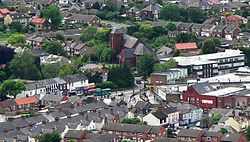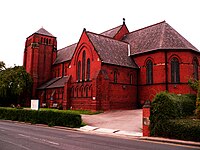Eston
| Eston | |
| Yorkshire North Riding | |
|---|---|
 A view of Eston Square from Eston Hills | |
| Location | |
| Grid reference: | NZ554187 |
| Location: | 54°33’36"N, 1°8’38"W |
| Data | |
| Population: | 7,005 (2011) |
| Post town: | Middlesbrough |
| Postcode: | TS6 |
| Dialling code: | 01642 |
| Local Government | |
| Council: | Redcar and Cleveland |
| Parliamentary constituency: |
Redcar |
Eston is an industrial town in the North Riding of Yorkshire, in the very north of the county, within the conurbation along the mouth of the River Tees spreading eastward from Middlesbrough. It is part of a 'Greater Eston', which includes the outlying settlements of Grangetown, Normanby, South Bank, Teesville and part of Ormesby.
History
The land around Eston has been occupied since 2400 BC.
The 1850 discovery of ironstone in Eston Hills by industrialists from Middlesbrough (most notably Henry Bolckow and John Vaughan) saw Eston develop from a small farming settlement in 1850 to a thriving mining town.[1] Miners' cottages, although altered, can still be seen in parts of Eston. The mining history of Eston was the subject of A Century in Stone, which describes how the mines were responsible for making Teesside the iron and steel capital of the world. The film, by Craig Hornby of Pancrack Pictures,[2] sold out in local cinemas and across Australia.
The Teesside steel industry that was started from these mines eventually produced the steel that built the Sydney Harbour Bridge. The mines have been closed since 1949, after 100 years of production. In 1967, the Teesside steel industry became part of the nationalised British Steel Corporation, which in turn became the Corus Group. The Middlesbrough area became the world's leading iron and steel producing capital initially due to the output of the Eston mines.
Eston Square
Eston Square, the shopping area on the main road passing through Eston, forms more of a triangle than a square. The square has a war memorial as its centrepiece – The Tomb of the Unknown Soldier – that shows the statue of a soldier atop a plinth. The plinth lists the names of local people who died during the World Wars.
Two sides the square are lined with traditional terraced shops, while the third side has the 1960s-built Eston Precinct parade of shops. Eston Square provides an important retail facility for a much wider area than just Eston itself.
Churches
- Church of England: Christ Church
- Independent / Evangelical
- Roman Catholic: St Anne's
Christ Church is is the partner church to St George's Church in Teesville. It a traditionally designed church built in red brick. It features sixteen stained-glass windows in dressed sandstone settings that bring warm colourful light into the main body of the building; they are themed around saints.[3]
Eston Hills
The town of Eston stands at the foot of Eston Hills, a ridge about 650 feet above sea level, and a part of the Cleveland Hills. The same hills had in past ages a beacon, the remains of which can still be seen at Eston Nab. Eston Nab is also home to Bauer Teesside and aerials and transmitters.
Wildlife on the hills includes lapwing, curlew, green woodpecker and linnet. There are various butterflies and dragonflies.
The hills overlooking Eston are managed for their wildlife, archaeology and amenity. Many people use the hills for walking, cycling and horse riding.
The Eston Hills provide access to the wider countryside via the public right of way network. Eston Nab commands an excellent view of the nearby Roseberry Topping, which stands higher at 1050 feet.
Outside links
| ("Wikimedia Commons" has material about Eston) |
- Genuki – History of Eston parish & District Descriptions from Bulmer's History and Directory of North Yorkshire (1890)
- Some pictures of Eston in the past


